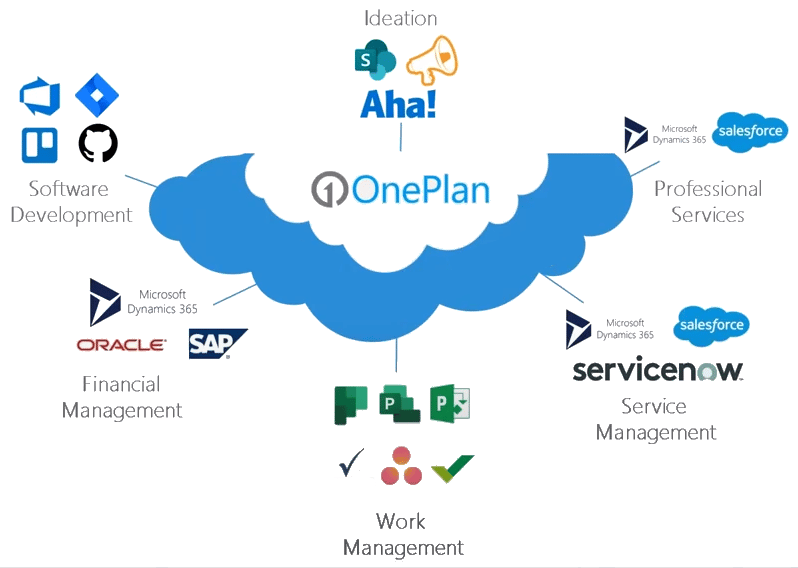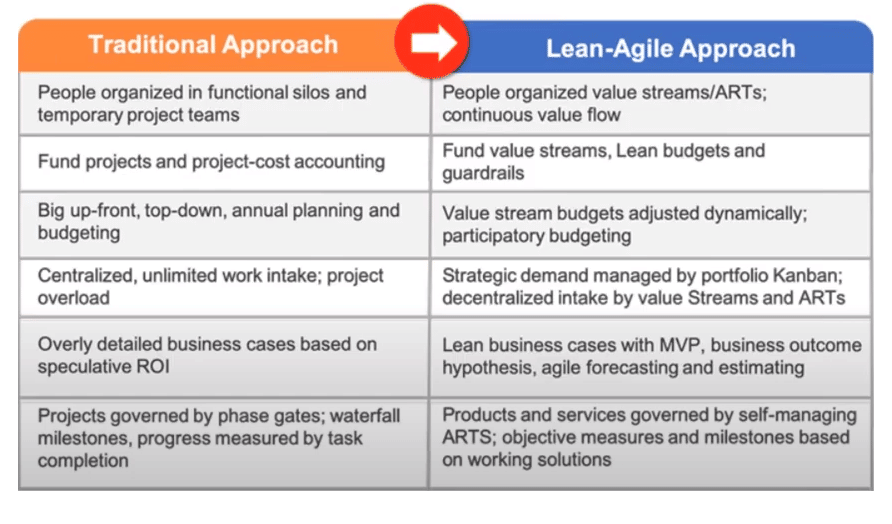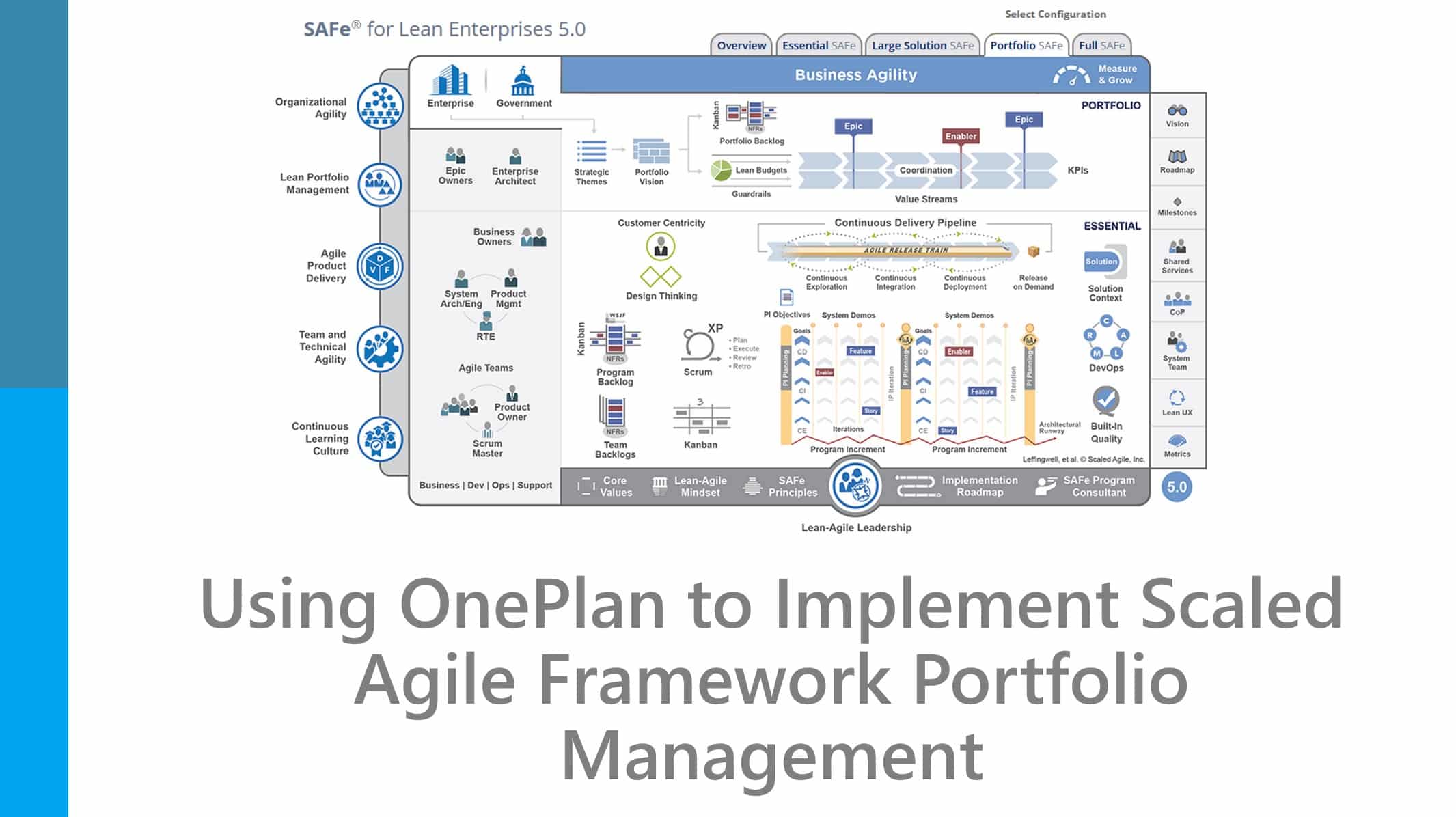Why is OnePlan used to Implement Scaled Agile Frameworks
OnePlan offers a strategic portfolio, financial, and resource management solution that can fit the needs of every PMO despite their current capabilities. This flexibility allows you to optimize portfolios, financials, and resources enterprise-wide and can be connected using a vast array of applications, giving you a clear understanding and better visibility within your enterprises’ portfolio.
When using OnePlan, a SAFe 5.0 Portfolio can manage several developmental Value Streams, each of which supports and develops a set of solutions that you can designate for a particular business or government agency. These portfolios typically represent a specific area of the company or enterprise.

When first creating a portfolio using OnePlan, you are automatically given a set of options to help shape the ideal portfolio for your enterprise. This helps guide aspiring organizations towards full utilization of agile-at-scale solutions and allows them the full benefits from the agile portfolio management solution for Azure DevOps.
OnePlan also integrates with all the other Microsoft applications, such as Azure, the Power Platform, Dynamics, Teams, Project, and Sharepoint, to name a few. If you are already familiar with the aforementioned Microsoft products, there is a good chance that you already use some portfolio tool. OnePlan, however, is the most adaptive and functional agile portfolio management application for these services, capable of linking into every single one of them for the best reports and accurate portfolio visibility.
OnePlan also uses OneConnect for external integrations, straight out of the box. These include ideation services like Aha! and Sharepoint, professional services such as SalesForce and Dynamics, business workflow tools such as Services Now, and even development areas such as Github. OnePlan also has several financial connections such as Oracle and SAP, for top-down visibility on your finances within the portfolio. This list continues to grow for plug and play accessibility straight out of the box.
It is not uncommon to see multiple portfolios present in larger enterprises; these can all be configured by using the OnePlan lean-agile portfolio configuration system. This system allows you to configure everything at a granular level to ensure your portfolio works for your enterprise.
OnePlan has three solutions to portfolio management. These are;
- Strategic Portfolio Management.
- Agile Portfolio Management.
- Adaptive Portfolio Management.
When transitioning over to OnePlan using a SAFe 5.0 Portfolio, you can adapt your agile portfolio management to use value streams, epics, features, and projects among user stories to create an easy to understand and informationally valuable portfolio.
Why OnePlan’s Lean-Agile approach is better than traditional PPM services
When compared to traditional PPM services, there are several practices that are inconsistent and inefficient at keeping portfolios properly managed and maintained. For example, in conventional approaches, people are organized in functional ‘silos’ and temporary teams that can fall through and create difficulties down the road. With a lean-agile system, people are organized by using value streams, enabling continuous value flow.
Traditionally, funded projects and project-costs are all done manually, which can be time-consuming and also inefficient. However, using a lean-agile approach to your portfolio can support value streams, learn budgets, and guardrails that can be adjusted dynamically with participatory budgeting.
Also, some other PPM services use a centralized, limitless work intake, that can cause project overload, putting pressure on the people and resources involved. On the other hand, Lean-agile approaches don’t, as they provide strategic demand managed by portfolio Kanban, which is a decentralized intake by value streams and ARTs (Agile Release Train).

Not only this but projects governed by phase gates, such as waterfall milestones, have progress measured by task completion, whereas newer, lean-agile approaches self-manage using ARTs, keeping objective measures and milestones based on working solutions.
When lined up against a traditional approach to PPM, lean-agile strategies using OnePlan can help wrap up any inefficiencies and help you create a better, more manageable portfolio for clearer visibility all round.
In some cases, you may also be aligned to overly detailed tasks, projects, and events based on speculative ROIs, leading to investment concerns. Using OnePlan negates this and can create lean business cases using MVP, business outcome hypothesis, and agile forecasting and estimating.
The way that OnePlan organizes and provides an agile approach to portfolio management relies heavily on the way the portfolio’s hierarchy is set up. In each section, it has a Kanban that organizes and feeds information into the next. For example, epics have a portfolio Kanban, that when a portfolio backlog is created, the information is piped into the Program Kanban within the Features section, which is further directed into the Team Kanban, under stories. With this, aligning the planning feature is an excellent function to have compared to traditional PPM methods.
Moving to an Agile Portfolio Management
When moving to an agile-portfolio, it always starts with a business agility conversation. These roadmaps can take around 3-4 years for completion, but that does not always mean it takes that long to transition. To shorten the planning process, it is important to determine if the move is possible, feasible and how to accelerate your business towards the transition to an agile business model using agile portfolios.
Once you have determined if the move to agile is feasible, it is essential to look at three areas for shifting towards business agility. The areas that need to be addressed when planning and transitioning towards lean-agile are strategy and investment funding, agile portfolio operations (which may mean transitioning your existing PMO), and lean governance. These components all come together to engage and realize the potential of a lean-agile approach.
OnePlan Modules
OnePlan portfolio and delivery modules are excellent at delivering the best quality dashboards and provide great visibility all around. On the portfolio end, you can have an overall portfolio plan, a resource plan, and a financial plan. All three of these areas can be integrated seamlessly for improved efficiency. On the delivery side, you can create agile-plans coming in from OneConnect to include Epics, Features, and Stories and can store them while providing status reporting at the same time. If you use Project, you can also use Work Plans that allow you to schedule everything out, all using OnePlan’s modules.
Conclusion
Using OnePlan for agile portfolio management is a great tool to utilize if you use any of Microsoft’s services or would like to use its out-of-the-box integrations that also tie into 3rd party applications. Moving to an agile portfolio management system can be a daunting task. Still, it is worth the time and effort to move to a more scalable, efficient, and a viable strategy to allow your business to achieve portfolios without limits.

